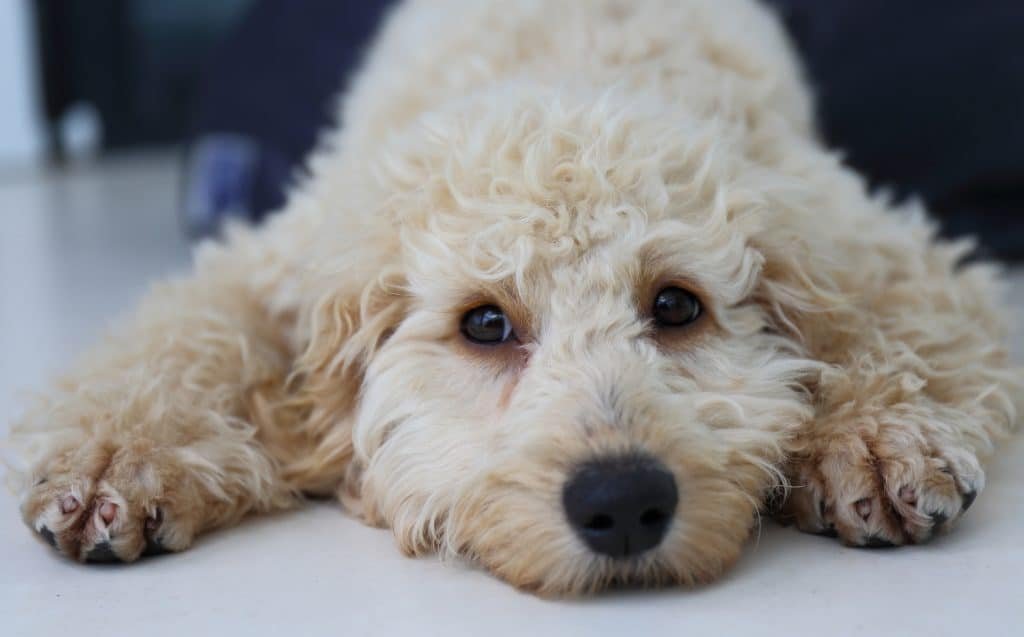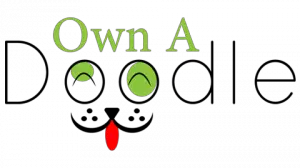If you are obsessed with Labradoodles, you must know they come in different sizes and have different appearances. Some are small and have wavy coats, while others are larger and leaner but have curly coats. This is because Labradoodles are hybrid dogs that are bred in various generations. While they all come from Labrador Retrievers and Poodles, the ratio of genes is what determines what the offspring will look like.
Labradoodle generations are represented by terms like F1, F2, etc. The letter ‘F’ stands for Filial Hybrid. This simply indicates that your dog is a crossbreed. The numbers, on the other hand, represent the generation number. In general, the more popular generations are the ones that have more Poodle genetics since Poodles are non-shedding and hypoallergenic dogs and therefore easier to maintain.
Here is a breakdown of the Labradoodle generations, their coat, and their shedding tendencies.
| Generation | Cross | Genetics | Coat | Shedding |
| F1 | Lab and Poodle | 50% Labrador, 50% Poodle | Varies | Possible |
| F1B | F1 and Lab/Poodle | 25% Labrador, 75% Poodle | Wavy or Curly | Low/None |
| F1BB | F1B and Lab/Poodle | 12.5% Labrador, 87.5% Poodle | Curly | Low/None |
| F2 | F1 and F1 | 50% Labrador, 50% Poodle | Varies | Low |
| F2B | F1 and F1B | 37.5% Labrador, 62.5% Poodle | Wavy or Curly | Low |
| F2BB | F2B and Poodle | 18.75% Labrador, 81.25% Poodle | Curly | Low/None |
| F3 | Multi-Generation | At least 60% Poodle | Usually Curly | Low/None |
Understanding Different Labradoodle Generations
Labradoodles come in first, second, and third-generation puppies. A first-generation pup comes from a purebred Labrador Retriever and a purebred Poodle. A second-generation dog comes from breeding two Labradoodles together.
The third generation takes the breeding process a step further and comes from breeding two second-generation Labradoodles. If you see the letter ‘B’ in a generation, such as the F1B, this refers to a backcross, meaning that a first-generation Labradoodle is crossed with a purebred.
Different generations can sometimes also lead to different traits in your dog. This guide explores Labradoodle generations in detail and discusses various physical characteristics associated with the most sought-after generations
F1 Labradoodle
The F1 generation is the original Labradoodle that comes from breeding a purebred Labrador Retriever and purebred Poodle. Since these pups contain 50% genes from each of their parents, their coat, color, and appearance can vary.
Owing to their Poodle parent, they may be low-shedding dogs, but they might also take after their Labrador parent and be prone to shedding. It is impossible to say which parent’s traits will be dominant in these puppies, and you will know once you see a pup’s actual coat.
For a general rule of thumb, the curlier the coat, the closer the dog is to a Poodle, and therefore the lesser the shedding.
On the plus side, first-generation Labradoodles are generally healthy dogs. When any dog is crossed with another purebred, this leads to healthier offspring since hereditary health issues, and deformities usually don’t transfer outside one breed.
The resulting pupping acquire the stronger genes and therefore tend to be more sturdy against allergies and diseases. This is called Hybrid Vigor.
F1B Labradoodle
The F1 generation branches into the F1B, a first-generation Labradoodle crossed with a purebred Poodle. These are among the most hypoallergenic Labradoodles since they inherit most of their traits from their Poodle parent.
F1BB Labradoodle
When the F1B Labradoodle is crossed with a 100% Poodle or Labradoodle, the result is the F1BB generation. More often than not, the backcross is a Poodle to maximize the hypoallergenic benefits.
This generation is the most likely to be non-shedding and therefore ideal for homes with sensitivities to pet fur.
F2 Labradoodle
These second-generation puppies come from a cross between two F1 Labradoodles. Since they have an inheritance ratio similar to the F1 generation, the coat and shedding vary highly. The pups may have straight, wavy, or curly coats.
F2B Labradoodle
F2 Backcross Labradoodles are a cross between an F2 dog and an F1B dog. This generation is also likely to have more Poodle qualities and generally has a wavy or curly coat. While it is difficult to predict the exact attributes, it is expected that F2B Labradoodles will have less shedding and therefore be more likely to be hypoallergenic dogs.
F2BB Labradoodle
An F2B Labradoodle crossed with a purebred Poodle creates the F2BB generation. This, therefore, has the highest Poodle genes after the F1BB. The generation is highly sought-after because of its low to no shedding and is best suited for pet owners with allergies to dog hair.
F3 Labradoodle
The F3 generation generally comes about from a cross between two F1B Labradoodles. However, it can also come from other crosses like F3 and F2 and is often referred to as Multi-Generation.
While the gene ratio varies in these pups, they are almost always at least 60% Poodle which means their coat is likely to be wavy or curly, and shedding is likely to be less to none.

What Generation of Labradoodles Are Best for Allergies?
Since Labradoodles are hybrid dogs, they can never be called 100% hypoallergenic. However, thanks to their Poodle parent, some generations are more likely to be hypoallergenic and therefore perfect for families that are allergic to dander from shedding pet hair.
As a general rule, The F1B, F1BB, F2B, and F2BB generations are the most likely to shed the least, and therefore ideal if you are looking for a dog that won’t shed. While their curly coats are beneficial for allergic family members, they also mean you must take care of their grooming regularly.
They don’t shed their fur, which is why it has to be regularly brushed and trimmed to avoid matting and tangling.
Is the F1 Generation Labradoodle Better Than F2?
It can be confusing to choose between these two generations because of their similar genetic makeup. Some experienced breeders recommend choosing an F1 over an FB, since both the parents are purebred, and the physical traits are therefore somewhat more predictable than the F2.
On average F1 Labradoodles certainly have a higher Hybrid Vigor than the F2 and are generally healthier and more resistant against common illnesses.
Do Different Labradoodle Generations Have Different Personalities?
Labradoodles are known to be intelligent, friendly, and social dogs. They love to bond with humans and make for excellent family dogs. Since there are no aggressive tendencies in either of the parents, all generations tend to be good with children.
They love to play and have lots of energy, which can sometimes mean training them to stay calm in certain areas of the house. However, their clever trainability and eagerness to learn means you can easily teach them the desired behaviors. It is unlikely that Labradoodles’ personalities will vary widely across generations.
However, just like with any other dog, your pup will have an individual personality. How they turn out to be will also depend on the environment they are raised in and the temperament of their immediate owners. Overall, Labradoodles make for a great addition to any household!
